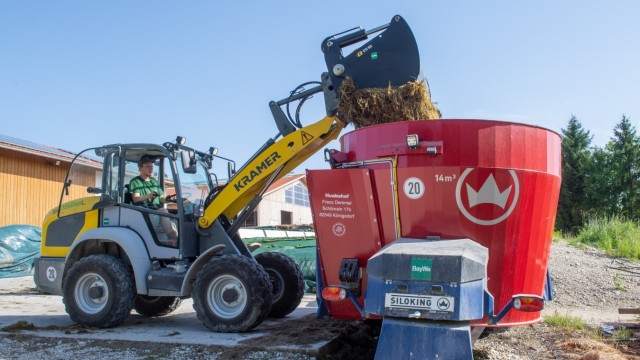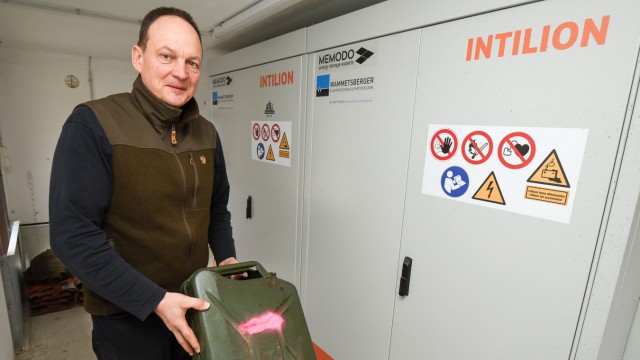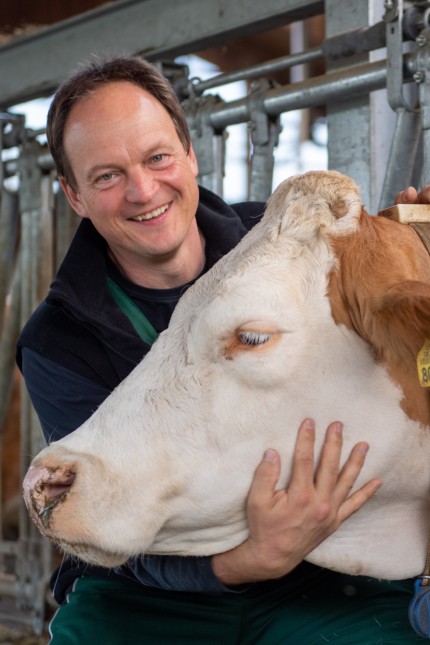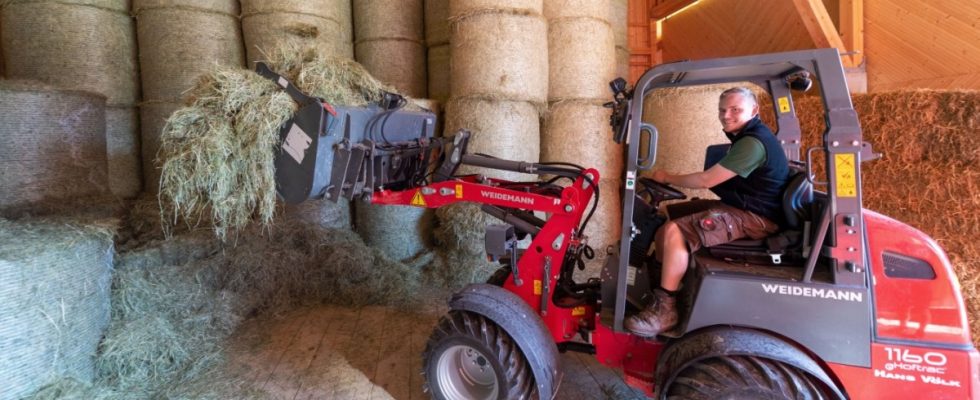The Huabahof in Schönrain has been a Naturland-certified organic farm for meat and milk production since 2005. At the same time, the technically ultra-modern farm is considered a unique model project that attracts visitors from all over the world. Franz Xaver Demmel, farmer and engineer, is testing with scientists how modern agriculture can be combined with climate protection and resource conservation.
SZ: Mr. Demmel, farmers are going to the barricades because the agricultural diesel subsidies are to be canceled. Do you understand that?
Franz Xaver Demmel: Excellent! But the problem runs deeper. Agricultural subsidies are not subsidies for farmers, but rather measures to make food cheaper. In Germany we have some of the lowest food prices in Europe, which is certainly good for social peace. Through taxes, the wealthy contribute more to the availability of cheap food than the less wealthy – a good principle in itself.
With tablet and pitchfork: Franz Demmel (left) runs the Huabahof together with his wife Gerlinde and son Xaver.
(Photo: Dairy Berchtesgadener Land/oh)
You have been working with electrical machines in Schönrain for several years. Isn’t that the direction in which agriculture should also move?
We use every technical opportunity to move away from fossil fuels. But unfortunately there is currently nothing on the market that could replace diesel in agriculture, especially in field use. I assume that this could take one to ten years, depending on the technology.
What’s the problem?
A power range of up to 80 hp can easily be operated electrically, for example a farm loader or a small tractor like the one Fendt will soon be releasing. A power range of up to 200 hp could be possible with hydrogen in the future – work is currently underway on this. This would enable larger tractors like those found here in the Oberland to operate. Electric is currently out of the question because the devices are becoming too heavy. And everything beyond that currently requires e-fuels or diesel. The removal of diesel subsidies comes at an inopportune time. The farmers currently have no chance of converting.
The new Tesla has more than 1000 horsepower. Fendt, on the other hand, is currently releasing a small electric tractor with 80 hp as a series model for the first time. Where is the problem?
Performance of this magnitude can certainly be designed, the problem is carrying the necessary energy. When harvesting, a tractor should have the required daily amount of energy with it – in the tank or in the battery. The Tesla mentioned has a battery capacity of 130 kWh, which is only enough for a tractor for a little more than an hour of average work. The tractor would therefore need a battery pack ten times the size – this creates the weight and price problem. The fact is: diesel has a very high energy density. During farm tours, I always explain this in the garage, where the batteries for running the stable are: That’s 137 kWh, and they’re the size of a small car. The amount of diesel that carries the same amount of energy fits in half a canister. On this occasion I always show a 200 liter barrel. On a nice day, our farm produces the energy equivalent of 200 liters of diesel via photovoltaics. So in five days I’ll have 1000 liters. Unfortunately not in diesel, but as stored electricity, and – status quo – I’m not bringing that into the field.

Wheel loaders and feed mixers run electrically on the Huabahof, while larger vehicles still run on diesel.
(Photo: Dairy Berchtesgadener Land/oh)

The batteries on the right in the picture hold as much energy as half a canister of diesel.
(Photo: Harry Wolfsbauer)
If the technology is a long time coming, what alternatives do the farmers in the Oberland have?
Theoretically, one could say: We are no longer driving large machines into the fields, but are returning to small-scale, biodiverse, sustainable and environmentally friendly agriculture. Smaller areas, more hedges in between, everyone is thrilled…
Yes, that sounds good.
Up to the sentence I’m saying now: Food prices would double. Society needs to understand that agriculture comes from the land and landscape. Here in the Oberland we still have this beautiful, small-scale landscape with forests, hedges and ponds – and we have a major competitive disadvantage: anyone who maintains this small, parceled landscape has no economic chance against regions like Mecklenburg-Western Pomerania. You don’t want to be Charles the Beetle in these monoculture agricultural deserts. But the farmers we need for the future are currently dying. We achieved this through low prices in agriculture. Let’s take the Gaißach farmers as an example, who still look after their Hoag in an exemplary manner, where the borders are planted with trees. Unfortunately, you cannot expect fair compensation for this additional effort.
So you have to turn the wheel back a bit?
Sustainable agriculture and forestry is the largest global eco-project that is lying idle. In Bavaria it is about 80 percent of the state’s area. Technically, all of this would be possible. And an increase in food prices would also be easy to cope with – on average, Germans only spend ten to twelve percent of their money on it. If you were to say: a little smaller cars, a little less vacation, less or no flying at all, foregoing two concerts a year – just keep things in moderation, then we would have the money to make lasting, positive changes to our country on the largest possible scale.

Franz Demmel with his favorite cow, Miss Schmid. Food prices should double, he says.
(Photo: Dairy Berchtesgadener Land/oh)
These connections are not new. What do you think needs to happen?
On the consumer side, only education helps. On the political side, one could simply legally limit the size of the plots: ten hectares, then they have to be separated with hedges or forest. What an impact that would have on water, climate and biodiversity! We are talking about a cultural landscape as it once was and as many traditional Upper Bavarian farmers still maintain it – with personal economic losses, mostly with two jobs and a 70 to 80 hour week.
Not everyone could spend more money on food.
Of course, there would have to be a parallel network for the socially weakest. Otherwise you can say: We have completely forgotten the value of food after three full generations. If we were to dig up a 120-year-old today and take him to a supermarket, he would say: You’re completely crazy! We are uninhibited. In the 1950s, people spent 44 percent of their money on food. We don’t want or need to go there anymore. But I would say now: 18 percent. You could set up an eco-project across Europe. Sustainable production urgently needs to be protected from cheaper natural overexploitation products from abroad.
Do you notice in your company that people’s awareness of shopping has changed?
Unfortunately, the trend has been going in the wrong direction for some time now. More and more people are switching from organic to brutal cheap products. The high-quality organic milk has sales problems. There is a new flight record at Munich Airport. In front of the microphone and camera, 80 percent of people speak out for sustainability, but at the checkout it is only ten to 15 percent. Country, landscape, agriculture, you quickly forget that – and fly to Bali.

